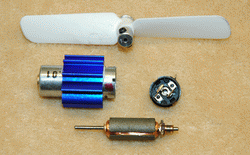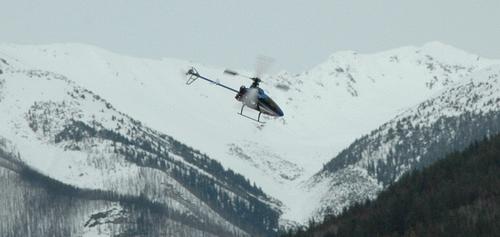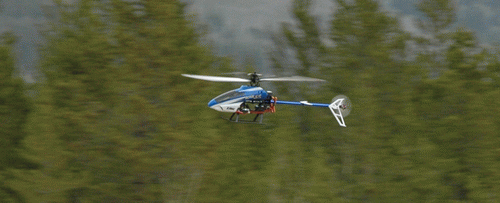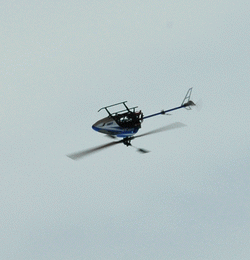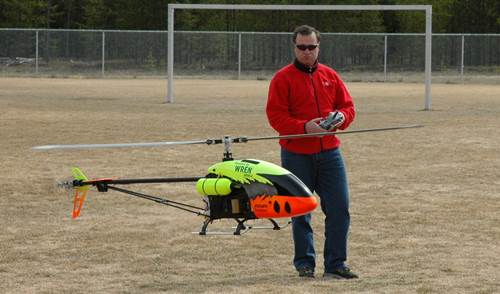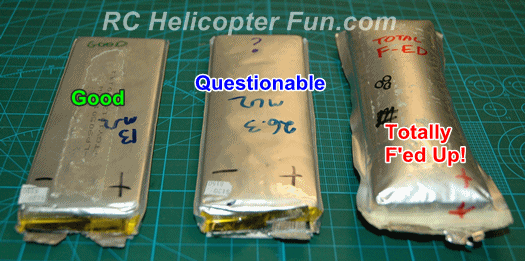E-flite’s Blade SR RC Helicopter Review
by John Salt
When I first heard the rumors about the Blade SR (single rotor) helicopter, I have to admit, I got pretty excited.
I heard it was going to be a 300 size bird and immediately thought to myself “better hold off on that T-Rex 250 purchase”; thinking the Bld SR would be a low cost 250 option, just as the Blade 400 is when comparing it to the T-Rex 450.
Update: The Blade SR has been discontinued.
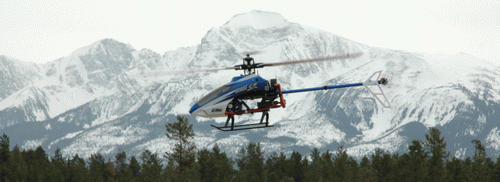
That however is not the case. The Bld SR’s target market is the budget minded beginner who wants to get into single rotor collective pitch RC helicopters with little hassle. The SR comes ready to fly (RTF) and includes the helicopter, radio, servos, gyro, LiPo battery, and charger all for around $130.00 USD.
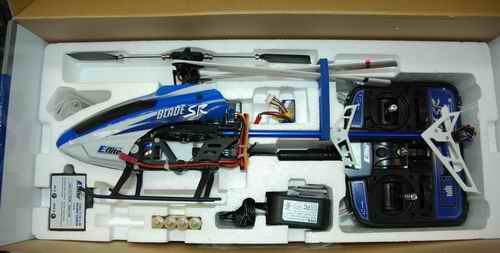
As you can see, the Blade SR is packaged nicely as is customary with all of E-flite's helis greatly reducing the chances of shipping damage and makes for a nice safe way to store and transport your SR.
E-flite has also recognized the importance of collective pitch and why it is so important even for beginners.
I hear a lot of forum discussions from folks who wished they would have released a fixed pitch version, unfortunately once up to this size of bird, fixed pitch is very difficult to control since you are always one step behind your lift control.
I explain this in much more detail if you look at that “collective pitch link” above. Collective pitch is the only accurate way to control lift with the instantaneous response needed to overcome the constantly changing translational lift for example.
A video of the Blade SR in Action...
Is There Much Difference Between The Blade SR and Blade CP+ & Pro?
The obvious difference is the use of a powerful and efficient brushless motor to drive the main rotor. This will give improved flight times, more power, and smoother/quicker throttle response. This alone is a long overdue upgrade to the antiquated brushed 370 power plants on the Blade CP’s. My guess is the Blade SR platform has been introduced to replace the Blade CP's over the next year or so, but that is just my humble guess.
The potential for the Blade SR platform is actually pretty exciting if they do come out with a belt or preferably, a shaft driven tail version. Looking at the layout, it wouldn't be that difficult and I seriously hope that is a product development being reviewed by E-flite or an aftermarket source.
The other big difference as I have already mentioned, is the Blade SR radio is setup with a tame values out of the box in contrast to the aggressive pitch range pre-programmed into the Blade CP and CP pro radios. As far as the claim it hovers at mid stick, well once again that is pretty normal for most non 3D collective pitch setups. I have all my helicopters set up for a mid stick hover in normal flight mode. Again, that is just how good beginner/trainer, scale, and light sport pitch curves are setup.
The Blade SR uses a much stronger molded main frame, very similar to the one used on the Blade 400 over the fragile stick frame used on the Blade CP’s. Any of you with Blade 400’s know how strong these molded frames are due in part to their built in elasticity and structural design. This again points to a phase out of the CP's and a natural evolution to a sized down Blade 400 platform.
No Blade SR BNF Version?
Nope, and likely for a good reason.. Considering the target market, a BNF version would add so many setup hassles and Horizon’s Tech Support line would be overwhelmed. The good news is it will still be very possible to bind the Blade SR to any DSM2/X Spektrum or JR computerized radio since it comes with a nice Spektrum AR6110e receiver. If you understand how to set up and level a 120 degree swashplate and setup your pitch and throttle curves, the Blade SR will fit very nicely into your model memory.
The big question is will this Blade heli hold up to the hype – or more specifically, will the tail rotor motor hold up to the stress?
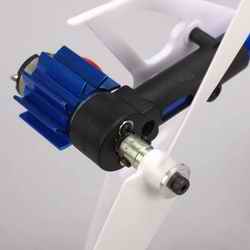
Electric tail motors are horrible little things on helicopters of this size.
Even with the smaller Blade mSR and 120 SR, tail blow out (when the tail looses its fight against the main rotor torque) still occurs, but it is much less noticeable and less frequent than on a larger electric tail motor heli like the Blade CP+, CP-Pro, and of course the Blade SR.
Having a tail blow out every now and then may not seem to be a big deal at first; but for a student/beginner RC heli pilot who has not learned the control reversals that occur during a nose in hover , it’s a huge deal! The disorientation and fear that results even from a moderate tail blow out of 20 degrees when you are first learning to hover and fly can have serious and expensive consequences.
Add to that tail motors on larger birds are under extreme stress and are not designed for the loads placed on them. The end result is motors that burn out quickly necessitating you to have your own little stock supply of spare tail motors if you do any amount of flying.
Align recognizes the issues with electric tail rotors as do all the mid to higher end heli manufactures and uses a belt driven tail with variable pitch on their T-Rex 250 for example and a brushless tail motor on their smaller 150. In fact, mid to high end manufacturers wouldn't even think of putting an electric tail motor on a helicopter of this size for the very simple reason they don't work well. I have to wonder would it really have cost much more to put a belt or shaft driven variable pitch tail rotor on the SR and if it will be an upgrade soon?
I sure hope so because out of the box with the settings programmed into the included 6 channel HP6DSM radio, the tail hold is just as bad as the rest of the electric tails out there once again proving that electric tails do not hold well. I have also been getting many e-mails from SR owners and the motors are dieing out pretty quick.
The little tail motor is working its guts out trying to keep up. Mine also had serious tail vibrations caused by the tail rotor hub not being centered correctly on the motor shaft. After fixing that, the tail vibrations were gone, but tail blow was still an ever present threat.
The specs on the box indicate the tail uses a coreless motor, but as you can see, this is NOT a coreless motor at all. Just a run of the mill 3 pole N60 motor.
Probably a print mistake on the box, but after a viewer pointed it out, I had to rip mine apart to be sure - disappointing? You bet!
A slower accelerating & decelerating 3 pole motor, despite the fact it is employing direct drive unfortunately means tail blow out is a constant worry if you make sudden changes to your throttle. I actually found it quite amusing that the instructions that come with the SR (pg.29) indicate in a "gentle way", that electric tail motor hunting is normal and not to confuse it with high gyro gain settings. Talk about identifying the underlying problem and pushing it aside.
The good news is the 3 pole tail motor seems to run fairly cool as the large heat sink seems to be doing a good job at dumping heat from the motor housing. It certainly wouldn't hurt to have a spare motor on hand (part number EFLH-1322) from the feedback I have been getting.
Is The Blade SR a Good Collective Pitch Trainer?
Out of the box, my opinion is NO. However, once bound and setup correctly on a computerized radio, things can be made much better.
For those of you who understand pitch & throttle curves and have read my “Setup & Tips for RC Helicopters” e-book , you know that any collective pitch heli can be a great trainer with the right settings. The fact that Horizon Hobby has recognized this and is finally offering a heli with docile settings in mind out of the box when the rest of the “RTF” industry is hell bent on high performance sport and 3D settings has me elated!
Unfortunately, the programmed settings in the HP6DSM radio are pretty poor. This is not necessarily a mistake due to bad settings, but goes to show the limitations with non computerized radios paired up with collective pitch helicopters that have 120 degree swashplates. There are just too many compromises that have to be made in the programming for simple radios to work across the board and suit the individual's needs. This is why I stress so many times that once up to this level of helicopter, the radio is more important than the bird.
The tame or normal pitch curve (mode switch position 0) on my Blade SR out of the box was certainly different and not at all what I expected. A low stick value of +4.5 degrees (that made sense but was on the high side). A mid stick hover was achieved with +7.5 degrees of pitch (again on the high side), and a high stick value of +14 degrees of pitch -INSANE! Certainly too much positive pitch on a small bird like this and for a beginner just learning to hover, that much lift power can get you into trouble fast.
The throttle curve in normal flight mode is a standard 0% to 100% linear throttle curve, no reduced power what soever making it very easy to rapidly gain too much altitude while learning. Another issue on my HP6DSM radio was the throttle output was not powering up the ESC & motor until the throttle/collective stick was at about 15-20%.
This made for an overly steep 0-100% power throttle curve causing large amounts of changing torque loads that the tail motor couldn't keep up to. Any moderate increase or decrease in power would cause significant tail blow out anywhere from 45 to 90 degrees with a violent counter correction. For a beginner RC helicopter pilot learning to hover, this would be very unnerving.
The Blade SR despite it's small size has a very low rotor RPM. At mid stick power (hovering) the head speed is only about 1950 RPM. A RPM this low is more consistent with larger 600 size electrics or 30-50 size nitro helicopters spinning 500-600mm blades. This is obviously why a normal hover pitch angle of about +4.5 to +5.5 isn't being used on the Blade SR and why a +7.5 value is used to create enough lift.
To allow for that slow head speed with no cyclic wobble, very soft head dampening is used on the SR and makes for very "mushy" cyclic control . For a beginner, having slower responding cyclic is a good thing, but the Blade SR is almost overkill and won't give most people a good "feel" for the controls or may cause over controlling. You can stiffen the head dampening with more shims to make the cyclic more responsive, but they are not included in the kit requiring you to have to purchase more (part # EFLH-1513).
With one more shim per side and bumping the rotor RPM up a bit, the cyclic response felt much better and what I would want a students cyclic "feel" setup like; but that of course as I said is personal preference. One other disappointment was the condition of the head dampener o-rings. When I went to add my additional head dampening shims, to my surprise after only 12 flights, the o-rings were already showing significant wear and damage. That is completely unacceptable and I sure hope this is not a common problem. Good thing the EFLH-1513 shim package I ordered contained two more o-rings as well.
The Stunt Mode throttle settings (switch position 1) were somewhat normal but the odd thing was the low stick output was higher than the high stick value. This was no 100% to 100% power curve, but more like a 100% to 85% curve. Perhaps that was just an issue with the radio that came with my Blade SR?
There is a knob beside the flight mode switch called the, ready for this... "SM TCM ADJ knob" - phew, that was a mouth full. This knob allows you to turn the curve into a more conventional "V" shaped throttle curve if it is turned all the way counter-clockwise. As the knob is turned clockwise, the throttle curve becomes flatter until it becomes a constant 100% full power flat line with the knob turned full clockwise. This knob only works in Stunt mode to alter the mid stick portion of the throttle curve, much the same way throttle hover trim does on more advanced radios.
A full power setting on the SR gets the head RPM up to about 2400 and certainly makes the cyclic more lively (it also eats those soft head dampening o-rings up as I mentioned). The reason you would want 100% power all the time, is to lessen the changes in torque as the rotor speeds up and down so there is less tail blow out. Unfortunately with the high rotor speeds the reactive torque is significant and the tail has a very hard time. As I said earlier, it is working its guts out, especially at higher head speeds.
The pitch curve numbers in Stunt Mode didn't make much sense. My SR was showing -4 degrees at low stick, +4 at mid, and once again +14 at high. The throttle hold pitch values are identical. These are actually good auto rotation numbers (not that you can auto a SR) but -4 is certainly not enough for sustained inverted flight, never mind inverted climb-outs.
Again, this is not a mistake on the programing, just the limitations and compromises that have to be made when pairing a simple radio with a heli like this. -4 degrees with full power does allow you to loop and roll, without much loss in altitude. I was very uncomfortable going inverted with the SR since the tail hold was so vague feeling.
Enough about the bad, let's look at the good...
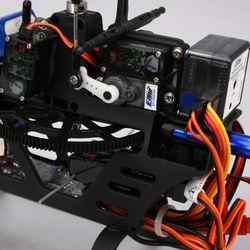
Once the Blade SR is bound to a computerized radio it becomes a totally different machine and if you program rather flat throttle curves, the tail can keep up very well to the changing torque loads.
I am still playing around with settings on my DX7 but it is getting better every flight. The biggest tip I can give is to keep the throttle curves as flat as possible, no more than a 5% difference between points if possible to keep the head speed constant throughout the collective pitch range. Do that, and the tail will not blow out much.
I was also able to improve the pitch curves to make the collective range more friendly and get rid of some swash level issues once I set the swashplate up correctly.
Programming in tail rotor dual rates and ATV limits enhances the pirouette rates making them both more consistent in each direction and more manageable. Despite what the instructions say, there was no dual rate for the rudder channel programmed into the HP6DSM radio that came with my SR. Only elevator and aileron channels had dual rates programmed.
This made tail control even worse and in a full speed pirouette with 100% rudder input, the SR spins impressively fast. Unfortunately, it will keep spinning when you center your rudder stick for up to 2 more pirouettes before the little tail motor can get it back under control. This is pretty scary during a 180, 540, or 900 degree stall turn and the first time I experienced it, I though I burnt out the tail motor.
Gyro gain out of the box is set with the gain potentiometer on the G110 gyro and it was set very well. Of course you can plug the remote gain gyro wire into the gear channel on the AR6100e receiver to enable remote gain settings from the transmitter and I did play around with the gain settings but really can't improve much on the factory setting. I know the G110 gyro works well from my experiences with it on the Blade 400, so that is another strong point and has wonderful potential if a belt driven tail is a future option.
The SR flies very smooth once you have it set up correctly and I found myself really enjoying the overall feel of it. In fast forward flight it is very stable, predictable, and quiet. The effects of electric tail twitch are greatly reduced with the "weather-vane effect" doing much of the tail stabilization in faster forward flight. You can actually hear when this happens as the tail rotor becomes very quiet since it is not working that hard.
Looping and rolling as I said was not comfortable with the tail twitching about as I transitioned from positive to negative pitch and back again. The soft mushy cyclic is certainly not confidence inspiring while trying to pull out of a loop with the ground approaching fast.
All that said, the Blade SR is not meant to be a sport flier, it is after all a docile machine and setup that way.
The Blade SR shines while flying nice controlled gentle scale type circuits, and that is after all what it's marketed for. For that type of flying the SR is fairly good. Wind is an issue with the small Blade SR due to both size and low rotor RPM, so light to no wind days are a must. The Blade SR will also do well at the school gym during the popular Friday night fun fly for the indoor crowd.
The next nice surprise was the flight times I was getting with the included 1000 mAh 3S LiPo. 10 minutes was easy and pushing it to 12 minutes is doable (not that you would or should push a LiPo down to 3 volts per cell). The Blade SR is by far one of the most electrically efficient helis I have ever flown and once you get some higher quality LiPo's in it, the flight times are indeed impressive.
The Blade SR is slightly tail heavy and you have to cram the stock E-flite battery pack as far forward on the battery tray as possible to get the center of gravity close to neutral. This means a slightly heavier and higher capacity 3S pack is very possible and the SR will have the power to lift it. Just as an experiment I put a large 1800 mAh pack on the tray and the SR was able to fly... Not that well or pretty since it was so nose heavy, but firing a slightly heavier 1100-1300 mAh pack up front is ideal.
Blade SR Battery Recommendations
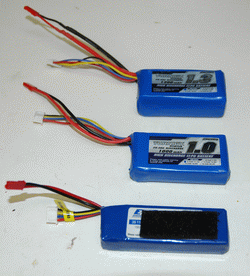
The stock E-Flite 1000 mAh 3S 15C pack that comes with the SR is adequate, but of course there are better and less expensive options. If you have read my LiPo battery write-up , you know I am a big fan of Hobby Kings line of Turnigy and Zippy Flightmax LiPo's if you are comfortable ordering direct from China.
I decided to try two different ones for my Blade SR and chose the
Turnigy ones since I like the softer, easy to manipulate silicone
balance leads. Pictured above is the stock E-flite pack at the bottom,
the Turnigy 1000 mAH pack in the middle, and the Turnigy 1300 mAh at the
top.
Turnigy's 3S 1000 mAh 20C pack is a very good choice for the Blade SR. It weighs only 3 grams more than the stock E-flite pack and is shorter in length but a little wider. The longer softer silicone wiring makes plug hook-up a breeze, and as I said, the soft silicone balance leads also make canopy installation easier since you don't have to fight with the balance plug.
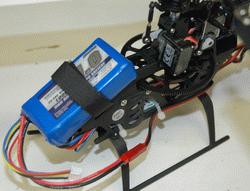
The very slight increase in weight plus the shorter length, makes it much easier to fit on the battery tray to obtain a perfect center of gravity which is so important with lighter helicopters. Both flight time and power output are a noticeable improvement over the stock E-flite pack and a 12 minute flight without pushing the pack too far is very doable. I was consistently getting 14 minutes actually with these packs, but that is pushing them too close to the low voltage cut off causing battery damage.
This pack is the best "plug and play" option since it comes with a JST power plug meaning you don't have to solder or splice a different plug onto it and the JST-XH balance plug works with the stock E-flite charge. Stick a little strip of Velcro on the back and you're all set. Of course, like all Turnigy LiPo packs, the best thing is the price... ONLY $5.49 USD!
I also gave Turnigy's 3S 1300 mAh 20C pack a go. This pack takes up the same footprint as the 1000 mAh but is slightly thicker. It also weighs in substantially more than the stock pack, 36 grams more to be exact. That much extra weight on the SR means the tail is working much harder due to the increase in main rotor torque and it is noticeable with much more tail blowout and twitching.
The flight times with this pack were insane however. 15 minutes is safe and I was getting up to 18 minutes if I pushed it (again, not a good thing to do). All these times were achieved flying normal circuits - no aerobatics other than slow stall turns.
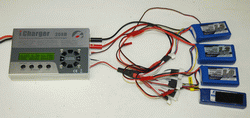
This 1300 mAh pack comes with a larger power connector however, so you will have to splice on a smaller JST plug. It still uses the JST-XH balance plug making stock charger recharging possible or better yet, use a computerized charger .
Once again the cost of this pack is so good, ONLY $8.95USD. I feel however for the added weight which caused the already poor tail performance to get worse, stick with the lighter 1000 mAh Turnigy pack. If on the other hand a shaft or belt driven tail conversion ever comes into the mix - this 1300 pack will be the one!
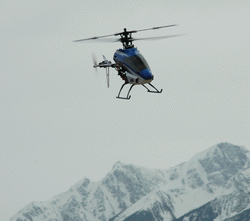
The blue and white canopy may look nice up close, but as you can see, the small size coupled with either dead light or a blue sky makes the SR very difficult to see at any distance, especially during a nose in position.
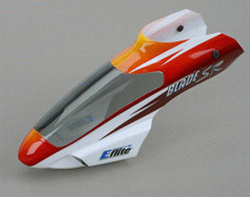
There is a brightly colored high visibility orange/red SR canopy (EFLH-1521) available and I highly recommend picking one up once you are flying circuits. It would be nice if the SR came standard with that canopy.
Final Thoughts
To say I was disappointed with the SR is obvious, but really not unexpected. I knew the limitations with electric tail motors and simple radios. The fact that the SR becomes a much better bird once bound to a computerized radio like a Spectrum DX6i up to a JR X12, shows the overall potential of this heli. Get rid of that rotten electric tail motor and fire on a belt or shaft drive and the SR will be a wonderful little helicopter. Let's hope someone is working on that right now. In fact, if the tail would hold better, the included radio settings would not be too bad.
As several of my viewers have already mentioned in e-mails to me, the Blade 450 is a much better machine and set up correctly with tame values makes a much better trainer. It is easier to fly, more stable, easier to see, easier to work on, and just more adaptable than the SR. Physics will never change... The larger the machine, the easier they are to fly. I guess the best thing I can say about the Blade SR is it made me appreciate just how good the Blade 450 really is.
Of course the Blade 450 costs more but much of that extra cost is in the better radio you get with it. If you did purchase a Spektrum DX6i radio with your Blade SR, the price difference is not as significant between the two anymore. On top of that, many of the Blade 400 parts cost the same or even slightly less than SR parts so repair/upkeep costs will be very similar between the two. Just something to keep in mind. If you are torn between the Blade 450 or the SR, the nod hands down goes to the 450.
If you want to get into a collective pitch heli for $130, the Blade SR despite its shortcomings is better than most in this price range for the simple reason it has the potential to be bound to a computerized radio out of the box and is built well with decent components. It will be trickier to learn on over a higher quality larger machine and harder to control however.
I am having a fair amount of fun with the Blade SR now that I have it is setup to my liking. As I said, it excls at big fast circuit flying with big bold turns if you keep the head speed consistent with no abrupt collective pitch changes. Due to the low noise level, it doesn't attract too much attention making it a nice park or school yard flier. If you are interested in the Blade SR Red Rocket Hobbies as usual is offering very competitive pricing.
One more look at the SR...
Blade SR Specifications
- Type: Ready To Fly 300 size micro electric single rotor collective pitch with motor driven tail
- Length: 485mm (19.1”)
- Height: 176mm (6.9”)
- Main Rotor Diameter: 552mm (21.8”)
- Tail Rotor Diameter: 82mm (3.2”)
- Flying Weight (with battery installed): 340g (12.0oz)
- Swashplate Type/Mixing: 120 degree - electronic mixing
- Main Motor: 3900Kv Brushless
- Tail Motor: 3 Pole Brushed N60 / Direct Drive
- Radio: Basic 6 channel 2.4 GHz DSM non-computerized (HP6DSM)
- Receiver: Spektrum AR 6100e
- Servos: E-flite DS75 micro digital (0.11 sec/60 deg @ 4.8V)
- Gyro: E-flite G110 Heading Lock with Remote Gain
- Speed Control: 2 in 1 ESC and Tail Rotor Mixer
- Battery: 3S (11.1V) 1000 mAh 15C with JST balancing tap Lithium Polymer (LiPo)
- Charger: 800 mA 3S LiPo balancing charger with 12VDC using included 1.5 amp 12 volt adaptor, or alligator clips to hook to a field box or vehicle battery
